- Home
- Robert Silverberg
Hunt the Space-Witch! Seven Adventures in Time and Space
Hunt the Space-Witch! Seven Adventures in Time and Space Read online
EARLY BIRD BOOKS
FRESH EBOOK DEALS, DELIVERED DAILY
BE THE FIRST TO KNOW ABOUT
FREE AND DISCOUNTED EBOOKS
NEW DEALS HATCH EVERY DAY!
Hunt the Space-Witch!
Seven Adventures in Time and Space
Robert Silverberg
Contents
INTRODUCTION
SLAVES OF THE STAR GIANTS
SPAWN OF THE DEADLY SEA
THE FLAME AND THE HAMMER
VALLEY BEYOND TIME
HUNT THE SPACE-WITCH!
THE SILENT INVADERS
SPACEROGUE
A Biography of Robert Silverberg
Introduction
A long time ago (upwards of sixty years), in a galaxy far, far away (it was Brooklyn, actually, but that’s quite a distance from where I live now) a high-school chum gave me a beaten-up copy of a pulp magazine called Planet Stories. I was just in the first heady rapture of discovering the science fiction magazines, and he had found a copy of the Summer, 1942 issue of Planet around his house, probably something his father had read and discarded, and thought, quite rightly, that I would like to have it.
I was already a devoted reader of Astounding Science Fiction and Amazing Stories and Fantastic Adventures, but Planet was new to me. I fell upon it with rapture. The magazine, seven years old at the time, was mussed and scuffed and had lost its cover, but to me it was a treasurehouse of wonders. Somewhere along the eons I replaced it with a fine shiny copy, which is sitting beside me as I write this, so I can tell you exactly what it contained: three novelets, by Ross Rocklynne, Ray Cummings, and Manly Wade Wellman, five short stories, and an 11-page column of fan letters from readers. (More about that letter column in a moment.)
The specialty of Planet Stories was tales of action and adventure, colorful yarns set on other worlds. The lead story, Ross Rocklynne’s “Task to Lahri,” with a lovely, moody two-page illustration by an artist named Leydenfrost, dealt with the visit of a spacefarer from Earth to the tenth world of our solar system, where a lost race lived in the hollow interior. Wellman’s “Venus Enslaved” was a tale of a castaway Earthman and crossbow-armed Amazons in conflict with the gigantic bestial Frogmasters of our neighbor planet. Nelson Bond’s “Operation Chaos” told of an attempt to run the blockade of the spaceways that the Outer Planets Alliance had set up.
You get the idea. Space opera, wild and fast and furious. I loved it. I was fourteen years old. I rushed out to the newsstand to see if Planet Stories still existed, and, yes, there it was: the Winter, 1949 issue, featuring “The Dead-Star Rover,” which the cover blurb called a “startling novel” by Robert Abernathy, and “Sword of Fire,” described as “a novelet of an Enslaved Universe” by Emmett McDowell. I handed over twenty cents for it. A day or two later I visited a second-hand bookstore where, for a dime more, I picked up the previous issue, Fall, 1949, which gave me my introduction to the work of Leigh Brackett (“Enchantress of Venus”). Over the next few years I assiduously collected a complete file of the magazine, going back to the first issue in 1939, and I faithfully bought and read every new issue that appeared until the magazine expired in the summer of 1955.
By the summer of 1955 I had precociously begun my own writing career, with a couple of story sales in 1954 and then a whole slew of them the following year. One magazine that I was desperately eager to crash was Planet, but I was just a little too late for that. I had already begun submitting stories of my own to the magazine as far back as 1950, and its editor at the time, Jerome Bixby, had read them sympathetically and claimed to see in them the work of someone who would be a successful writer someday—but he didn’t buy any of them. My work didn’t reach a really professional level until about 1954, and by then Planet, to my eternal regret, was wobbling toward its doom and buying no new material. So I never did get a chance to have some grand and gaudy space’ adventure published in that grand and gaudy magazine.
Let’s go back to the letter column of that battered, coverless 1942 issue that my high-school friend had given me in 1949, though. Among the fans whose letters were published in it was a certain Larry Shaw of Schenectady, New York. Soon I would learn, by looking at back-issue magazines, that Shaw was a regular contributor of such letters to the magazines, and was known in the science-fiction world as a shrewd critic of the genre. He left Schenectady eventually to become the editor of a hot-rod magazine, and by 1953 he was working as associate editor of one of the best s-f magazines of the day, If. He and I met at my first science-fiction convention, in Philadelphia in September, 1953, and we took an immediate liking to each other. I was then just on the threshold of my writing career, and he gave me some useful, encouraging advice.
By the summer of 1955 Larry had left If to become the editor of another new magazine, Infinity Science Fiction. That fall I visited his office in midtown Manhattan, told him of the success I was suddenly having as a writer, and offered him a story, which he bought and published in the fourth issue, dated August, 1956. He bought another and used it in the fifth issue. From then until the magazine went out of business in 1958 I would be a regular contributor.
And one day in the summer of 1956 Larry said to me, “We’re going to revive Planet Stories. How would you like to write some space-action stuff for us?”
He wasn’t going to call it Planet Stories, of course. At that time the name still belonged to the company that once had published it. He wasn’t going to use the old shaggy-edged pulp format, either, because the day of the pulp magazine was over. The new magazine would bear the appropriately explicit title of Science Fiction Adventures and it would be printed in what was now the standard digest-sized format for fiction magazines.
Naturally, I jumped at the opportunity. I told Larry how much I had loved the old magazine and how deeply I regretted never having had a chance to write for it—and then, in July, 1956, I sat down and produced a 20,000-word story with the resounding Planet-style title of “Battle for the Thousand Suns.” Larry bought it on the spot and asked for a second story of the same length, which I wrote a week later in collaboration with my writing partner of that era, Randall Garrett: “Secret of the Green Invaders.” When the first issue of Science Fiction Adventures appeared in September, 1956, I was responsible for half the fiction in it. (The issue also contained a novella by Edmond Hamilton and a three-page story by a new writer named Harlan Ellison.)
That was the beginning of my long and fruitful relationship with Larry Shaw’s Science Fiction Adventures, a magazine that lacked the flamboyant pulpy appearance of the old Planet Stories but came very close to reincarnating its spirit. Over the next couple of years, I would write the magazine practically single-handedly, reveling in the opportunity to tell outrageously exciting tales of the space lanes, and I have put some of the best of those tales together in the volume you are holding now.
Even before the first issue had appeared, Larry had handed me a rough sketch of a cover painting showing a giant alien being (with the sort of pointy ears we would one day associate with Mr. Spock) holding a test tube that contained a man and a scantily-clad woman. “Write a novella around that illustration for the second issue,” Larry said, and in September, 1956—about a week after I had won my first Hugo, as most promising new writer of the year—I turned out “Slaves of the Star Giants,” a story of time travel rather than space travel, which was the cover story in the February, 1957 issue. By now it was understood that I would write a novella for every issue of the magazine. For the third issue, which had a magnificent red-toned cover by Ed Emsh, I gave him “Spawn of the Deadly Sea,” a kind of Viking story ab
out a conquered Earth, one that would have fit perfectly into the old Planet Stories we all had known and loved. And in the fourth issue I began the trilogy of novellas under the pseudonym of “Calvin M. Knox” that I called the “Chalice of Death” series, which I eventually put together to form a novel, and which is not included here because the complete novel will be released in a different book from the present publisher. (Which, by no coincidence, calls itself “Planet Stories” too.)
I kept up the pace in just about all of the succeeding issues. The fifth issue ran “This World Must Die,” which I expanded into the novel “The Planet Killers” and which also is being reprinted elsewhere in its longer form. “The Flame and the Hammer” came out in issue six, September, 1957. The seventh issue, dated October, 1957 (the magazine now was appearing every month), was devoted almost entirely to my novel-length “Thunder Over Starhaven,” and this, too, you can find in the forthcoming Chalice of Death Planet Stories omnibus. (Larry insisted on printing it under the pseudonym of “Ivar Jorgenson,” which I had used once or twice in other magazines, though most stories under that byline—spelled “Jorgensen,” however—had been the work of a writer named Paul Fairman. Fairman was rightly annoyed, though publishers kept on sticking it on my work all the same.)
Issue eight, for some reason skipping a month and bearing the date of December, 1957, was also almost entirely the work of my busy typewriter: “Valley Beyond Time,” reprinted here, was the lead novella, and right behind it came the second of Calvin Knox’s “Chalice” stories. And so it went into 1958: my “Hunt the Space-Witch!” another “Ivar Jorgenson” novella, led off the January, 1958 issue, number nine. It too is reprinted here. The tenth issue brought the third “Chalice” novella, and the eleventh, April, 1958, contained my 40,000-word novel “Shadow on the Stars,” which eventually was published as a separate novel and now is included in one of my novel omnibuses.
Hard times were coming to the science-fiction magazines of that period, though. One of the biggest magazine distributors of the time abruptly went out of business in the spring of 1958, taking a lot of magazines with it. Science Fiction Adventures, to my great sorrow, was one of those that folded. (The final issue, dated June, 1958, contained two short stories of mine, but no novellas—I must have been busy that month meeting some other editor’s deadline.) Generally, though, I kept the novellas flowing to editor Shaw’s desk even as the end was approaching, and, therefore, when Science Fiction Adventures went under he found himself left with a hefty inventory of Silverberg space operas. He had no choice but to use them in the surviving companion magazine, Infinity, which ostensibly was devoted to a more serious, contemplative kind of science fiction. (And for which I had written a great many stories also.) So the October, 1958 issue of Infinity featured “a great CALVIN KNOX novel” that had been intended for the other magazine, complete with a bright red Emsh cover that proclaimed in big letters, “WAS SHE A WOMAN—OR A MONSTER?” (Monsters were very big in magazine publishing just then.) The story was “The Silent Invaders,” which I later expanded into a novel. But I think the shorter version is superior, and that is the one that is included here.
Then, in the November, 1958 Infinity, lurking behind another Emsh cover depicting a really revolting alien being, came “Spacerogue,” my final novella for Larry Shaw in the old Planet Stories vein, which for some reason was published here under the pseudonym of “Webber Martin.” That was the end of the line. Infinity went out of business, I turned my attention to other kinds of science fiction (and a lot of non-science-fiction writing too), and the rest is, well, nostalgia.
But here they are again, brought together for the first time—seven of the action-adventure novellas that I wrote more than half a century ago for Larry Shaw’s Science Fiction Adventures, a magazine that was for both of us a way of showing our love for the wonderful old Planet Stories of our youthful years.
Robert Silverberg
December, 2009
Slaves of the Star Giants
Chapter One
Dark violet shadows streaked the sky, and the forest was ugly and menacing. Lloyd Harkins leaned against the bole of a mighty red-brown tree and looked around dizzily, trying to get his bearings.
He knew he was there, not here. Here had vanished so suddenly that there had been no sense of transition or of motion—merely a strange subliminal undertone of loss, as the world he knew had melted and been replaced with—what?
He heard a distant, ground-shaking sound of thunder, growing louder. Birds with gleaming, toothy beaks and wide-sweeping wings wheeled and shrieked in the shadowed sky, and the air was cold and damp. Harkins held his ground, clinging tightly to the enormous tree as if it were his last bastion of reality in a world of dreams.
And the tree moved.
It lifted from its base, swung forward and upward, carrying Harkins with it. The sound of thunder grew nearer. Harkins shut his eyes, opened them, gaped in awe.
Some ten feet to the right, another tree was moving.
He threw his head back, stared upward into the cloud-fogged sky, and verified the fact he wanted to deny: the trees were not trees.
They were legs.
Legs of a being huge beyond belief, whose head rose fifty feet or more above the floor of the dark forest. A being who had begun to move.
Harkins dug his hands frantically into the leg, gripping it as he swung wildly through a fifteen-foot arc with each stride of the monstrous creature. Gradually, the world around him took shape again, and slowly he re-established control over his fear-frozen mind.
Through the bright green blurs of vegetation he was able to see the creature on which he rode. It was gigantic but vaguely manlike, wearing a sort of jacket and a pair of shorts which terminated some twenty-five feet above Harkins’ head. From there down, firm red-brown skin the texture of wood was visible. Harkins could even distinguish dimly a face, far above, with pronounced features of a strange and alien cast.
He began to assemble his environment. It was a forest—where? On Earth, apparently—but an Earth no one had ever known before. The bowl of the sky was shot through with rich, dark colors, and the birds that screeched overhead were nightmare creatures of terrifying appearance.
The earth was brown and the vegetation green, though all else had changed.
Where am I? Harkins asked over and over again.
And—Why am I here?
And—How can I get back?
He had no answers. The day had begun in ordinary fashion, promising to be neither more nor less unusual than the day before or all the days before that. Shortly after noon, on the 21st of April, 1957, he had been on his way to the electronics laboratory, in New York City, on the planet Earth. And now he was here wherever here might be.
His host continued to stride through the forest, seemingly unconcerned about the man clinging to his calf. Harkins’ arms were growing tired from the strain of hanging on, and suddenly the new thought occurred: Why not let go? He had held on only through a sort of paralysis of the initiative, but now he had regained his mental equilibrium. He dropped off.
He hit the ground solidly and sprawled out flat. The soil was warm and fertile-smelling, and for a moment he clung to it as he had to the “tree” minutes before. Then he scrambled to his feet and glanced around hastily, looking for a place to hide and reconnoiter.
There was none. And a hand was descending toward him—red-brown, enormous, tipped with gleaming, pointed fingernails six inches long. Gently, the giant hand scooped Harkins up.
There was a dizzying moment as he rose fifty feet, held tenderly in the giant’s leathery embrace. The hand opened, and Harkins found himself standing on an outspread palm the size of a large table, staring at a strange oval face with deep-set, compassionate eyes and a wide, almost lipless mouth studded with triangular teeth. The being seemed to smile almost pityingly at Harkins.
“What are you?” Harkins demanded.
The creature’s smile grew broader and more melancholy, but there was no
reply—only the harsh wailing of the forest birds, and the distant rumbling of approaching thunder. Harkins felt himself being lowered to the giant’s side, and once again the being began to move rapidly through the forest, crushing down the low-clustered shrubs as it walked. Harkins, his stomach rolling agonizingly with each step, rode cradled in the great creature’s loosely-closed hand.
After what must have been ten minutes or more, the giant stopped. Harkins glanced around, surprised. The thunder was close now, and superimposed on it was the dull boom of toppling trees. The giant was standing quite still, legs planted as solidly as tree trunks, waiting.
Minutes passed—and then Harkins saw why the giant had stopped. Coming toward them was a machine—a robot, Harkins realized—some fifteen feet high. It was man-shaped, but much more compact; a unicorn-like spike projected from its gleaming nickel-jacketed forehead, and instead of legs it moved on broad treads. The robot was proceeding through the forest, pushing aside the trees that stood in its way with casual gestures of its massive forearms, sending them toppling to the right and left with what looked like a minimal output of effort.
The giant remained motionless, staring down at the ugly machine as it went by. The robot paid no attention to Harkins’ host, and went barrelling on through the forest as if following some predetermined course.
Minutes later it was out of sight leaving behind it a trail of uprooted shrubs and exposed tree-roots. As the robot’s thunder diminished behind them, the giant resumed his journey through the forest. Harkins rode patiently, not daring to think any more.
After a while longer a clearing appeared—and Harkins was surprised and pleased to discover a little cluster of huts. Man-sized huts, ringed in a loose circle to form a village. Moving in the center of the circle were tiny dots which Harkins realized were people, human beings, men.

 The Longest Way Home
The Longest Way Home Hawksbill Station
Hawksbill Station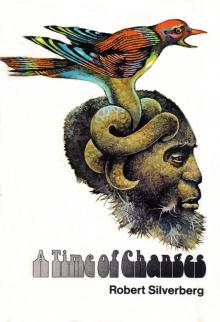 A Time of Changes
A Time of Changes This Way to the End Times: Classic Tales of the Apocalypse
This Way to the End Times: Classic Tales of the Apocalypse Beyond the Gate of Worlds
Beyond the Gate of Worlds Lord Valentine's Castle
Lord Valentine's Castle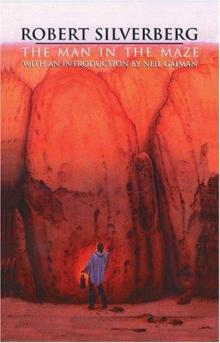 The Man in the Maze
The Man in the Maze Tales of Majipoor
Tales of Majipoor Time of the Great Freeze
Time of the Great Freeze The Collected Stories of Robert Silverberg, Volume 3: Something Wild Is Loose: 1969-72
The Collected Stories of Robert Silverberg, Volume 3: Something Wild Is Loose: 1969-72 Planet of Death
Planet of Death Trips: The Collected Stories of Robert Silverberg, Volume Four
Trips: The Collected Stories of Robert Silverberg, Volume Four In the Beginning: Tales From the Pulp Era
In the Beginning: Tales From the Pulp Era Hot Sky at Midnight
Hot Sky at Midnight Valentine Pontifex
Valentine Pontifex Up the Line
Up the Line Thorns
Thorns Amanda and the Alien
Amanda and the Alien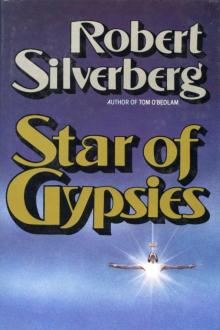 Star of Gypsies
Star of Gypsies Nightwings
Nightwings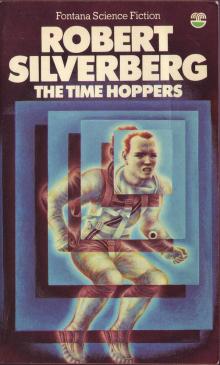 The Time Hoppers
The Time Hoppers Blood on the Mink
Blood on the Mink Dying Inside
Dying Inside The Last Song of Orpheus
The Last Song of Orpheus The King of Dreams
The King of Dreams The Stochastic Man
The Stochastic Man The Collected Stories of Robert Silverberg, Volume Seven: We Are for the Dark
The Collected Stories of Robert Silverberg, Volume Seven: We Are for the Dark The Millennium Express: The Collected Stories of Robert Silverberg, Volume Nine
The Millennium Express: The Collected Stories of Robert Silverberg, Volume Nine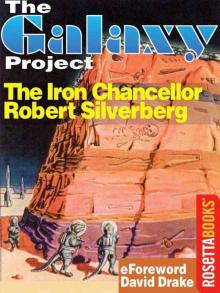 The Iron Chancellor
The Iron Chancellor Lord Prestimion
Lord Prestimion To Open the Sky
To Open the Sky The World Inside
The World Inside Chains of the Sea
Chains of the Sea The Collected Stories of Robert Silverberg, Volume Five: The Palace at Midnight
The Collected Stories of Robert Silverberg, Volume Five: The Palace at Midnight Postmark Ganymede
Postmark Ganymede The Second Trip
The Second Trip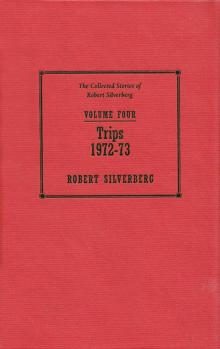 The Collected Stories of Robert Silverberg, Volume 4: Trips: 1972-73
The Collected Stories of Robert Silverberg, Volume 4: Trips: 1972-73 Son of Man
Son of Man Tom O'Bedlam
Tom O'Bedlam To the Land of the Living
To the Land of the Living To Be Continued: The Collected Stories of Robert Silverberg, Volume One
To Be Continued: The Collected Stories of Robert Silverberg, Volume One Shadrach in the Furnace
Shadrach in the Furnace The Chalice of Death: Three Novels of Mystery in Space
The Chalice of Death: Three Novels of Mystery in Space The Queen of Springtime
The Queen of Springtime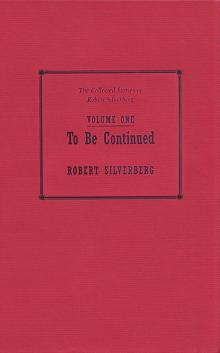 To Be Continued 1953-1958
To Be Continued 1953-1958 Legends
Legends Roma Eterna
Roma Eterna To Live Again
To Live Again At Winter's End
At Winter's End Needle in a Timestack
Needle in a Timestack To Live Again and the Second Trip: The Complete Novels
To Live Again and the Second Trip: The Complete Novels Lord of Darkness
Lord of Darkness The Mountains of Majipoor
The Mountains of Majipoor The World Outside
The World Outside The Alien Years
The Alien Years The Book of Skulls
The Book of Skulls The Face of the Waters
The Face of the Waters Gilgamesh the King
Gilgamesh the King The Collected Stories of Robert Silverberg, Volume 6: Multiples: 1983-87
The Collected Stories of Robert Silverberg, Volume 6: Multiples: 1983-87 The Happy Unfortunate
The Happy Unfortunate Three Survived
Three Survived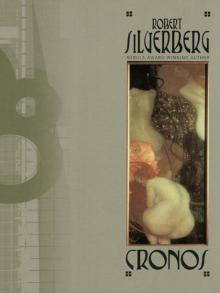 Cronos
Cronos Tower of Glass
Tower of Glass Legends II
Legends II The Planet Killers
The Planet Killers The Collected Stories of Robert Silverberg, Volume 2: To the Dark Star: 1962-69
The Collected Stories of Robert Silverberg, Volume 2: To the Dark Star: 1962-69 Downward to the Earth
Downward to the Earth Lord Valentine's Castle: Book One of the Majipoor Cycle
Lord Valentine's Castle: Book One of the Majipoor Cycle Hot Times in Magma City, 1990-95
Hot Times in Magma City, 1990-95 Hunt the Space-Witch! Seven Adventures in Time and Space
Hunt the Space-Witch! Seven Adventures in Time and Space Majipoor Chronicles
Majipoor Chronicles The Robert Silverberg Science Fiction Megapack(r)
The Robert Silverberg Science Fiction Megapack(r) Starman's Quest
Starman's Quest Car Sinister
Car Sinister Worlds of Maybe
Worlds of Maybe Fantasy The Best of 2001
Fantasy The Best of 2001 Revolt on Alpha C
Revolt on Alpha C Homefaring
Homefaring The Pardoner's Tale
The Pardoner's Tale Sailing to Byzantium - Six Novellas
Sailing to Byzantium - Six Novellas The Chalice of Death
The Chalice of Death Sundance
Sundance A Tip on a Turtle
A Tip on a Turtle Nebula Awards Showcase 2001: The Year's Best SF and Fantasy Chosen by the Science Fiction and Fantasy Writers of America
Nebula Awards Showcase 2001: The Year's Best SF and Fantasy Chosen by the Science Fiction and Fantasy Writers of America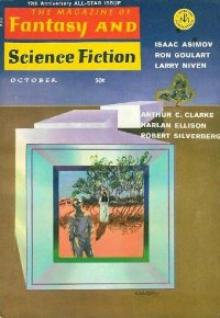 The Fangs of the Trees
The Fangs of the Trees The Palace at Midnight: The Collected Work of Robert Silverberg, Volume Five
The Palace at Midnight: The Collected Work of Robert Silverberg, Volume Five The Millennium Express - 1995-2009 - The Collected Stories of Robert Silverberg Volume Nine
The Millennium Express - 1995-2009 - The Collected Stories of Robert Silverberg Volume Nine Book of Skulls
Book of Skulls Passengers
Passengers Something Wild is Loose - 1969–72 - The Collected Stories of Robert Silverberg Volume Three
Something Wild is Loose - 1969–72 - The Collected Stories of Robert Silverberg Volume Three Multiples
Multiples Starborne
Starborne The Masks of Time
The Masks of Time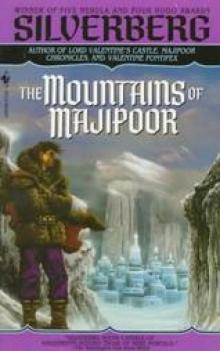 The Mountains of Majipoor m-8
The Mountains of Majipoor m-8 Multiples (1983-87)
Multiples (1983-87) Those Who Watch
Those Who Watch In the Beginning
In the Beginning Earth Is The Strangest Planet
Earth Is The Strangest Planet Collision Course
Collision Course Neutral Planet
Neutral Planet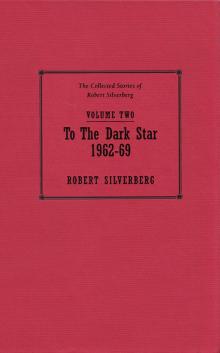 To the Dark Star - 1962–69 - The Collected Stories of Robert Silverberg Volume Two
To the Dark Star - 1962–69 - The Collected Stories of Robert Silverberg Volume Two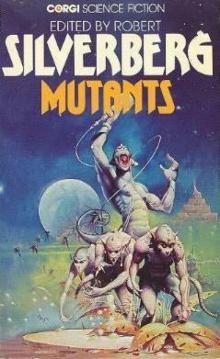 Mutants
Mutants Sailing to Byzantium
Sailing to Byzantium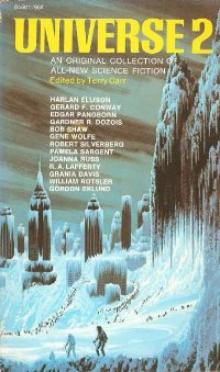 When We Went to See the End of the World
When We Went to See the End of the World Robert Silverberg The Science Fiction Hall Of Fame Volume One, 1929-1964
Robert Silverberg The Science Fiction Hall Of Fame Volume One, 1929-1964 To Be Continued - 1953–58 - The Collected Stories of Robert Silverberg Volume One
To Be Continued - 1953–58 - The Collected Stories of Robert Silverberg Volume One Valentine Pontifex m-3
Valentine Pontifex m-3 Gianni
Gianni Majipoor Chronicles m-2
Majipoor Chronicles m-2 We Are for the Dark (1987-90)
We Are for the Dark (1987-90) Waiting for the Earthquake
Waiting for the Earthquake Fantasy: The Best of 2001
Fantasy: The Best of 2001 How It Was When the Past Went Away
How It Was When the Past Went Away Beauty in the Night
Beauty in the Night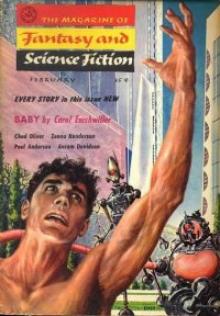 The Man Who Never Forgot
The Man Who Never Forgot The Book of Changes m-9
The Book of Changes m-9 Lord Valentine's Castle m-1
Lord Valentine's Castle m-1 This Way to the End Times
This Way to the End Times Queen of Springtime
Queen of Springtime Legends-Volume 3 Stories by the Masters of Modern Fantasy
Legends-Volume 3 Stories by the Masters of Modern Fantasy The Palace at Midnight - 1980–82 - The Collected Stories of Robert Silverberg Volume Five
The Palace at Midnight - 1980–82 - The Collected Stories of Robert Silverberg Volume Five Something Wild is Loose: The Collected Stories of Robert Silverberg, Volume Three
Something Wild is Loose: The Collected Stories of Robert Silverberg, Volume Three Multiples - 1983–87 - The Collected Stories of Robert Silverberg Volume Six
Multiples - 1983–87 - The Collected Stories of Robert Silverberg Volume Six Alaree
Alaree Three Survived: A Science Fiction Novel
Three Survived: A Science Fiction Novel Defenders of the Frontier
Defenders of the Frontier The New Springtime
The New Springtime We Are for the Dark - 1987–90 - The Collected Stories of Robert Silverberg Volume Seven
We Are for the Dark - 1987–90 - The Collected Stories of Robert Silverberg Volume Seven The Science Fiction Hall of Fame, Volume One 1929-1964--The Greatest Science Fiction Stories of All Time Chosen by the Members of the Science Fiction Writers of America
The Science Fiction Hall of Fame, Volume One 1929-1964--The Greatest Science Fiction Stories of All Time Chosen by the Members of the Science Fiction Writers of America Master Of Life And Death
Master Of Life And Death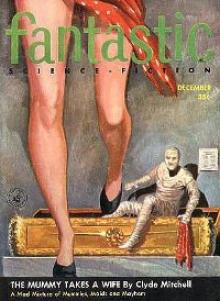 Choke Chain
Choke Chain Sorcerers of Majipoor m-4
Sorcerers of Majipoor m-4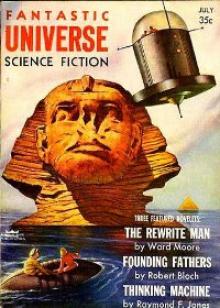 Absolutely Inflexible
Absolutely Inflexible Trips - 1962–73 - The Collected Stories of Robert Silverberg Volume Four
Trips - 1962–73 - The Collected Stories of Robert Silverberg Volume Four Hot Times in Magma City - 1990-95 - The Collected Stories of Robert Silverberg Volume Eight
Hot Times in Magma City - 1990-95 - The Collected Stories of Robert Silverberg Volume Eight Far Horizons
Far Horizons The Queen of Springtime ns-2
The Queen of Springtime ns-2 The Seventh Science Fiction Megapack
The Seventh Science Fiction Megapack Invaders From Earth
Invaders From Earth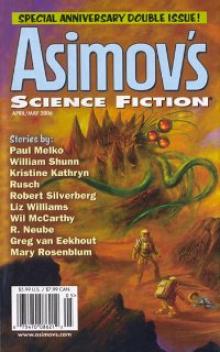 Hanosz Prime Goes To Old Earth
Hanosz Prime Goes To Old Earth The Macauley Circuit
The Macauley Circuit Science Fiction: The Best of 2001
Science Fiction: The Best of 2001 To the Dark Star: The Collected Stories of Robert Silverberg, Volume Two
To the Dark Star: The Collected Stories of Robert Silverberg, Volume Two Stochastic Man
Stochastic Man Legends: Stories By The Masters of Modern Fantasy
Legends: Stories By The Masters of Modern Fantasy To Live Again And The Second Trip
To Live Again And The Second Trip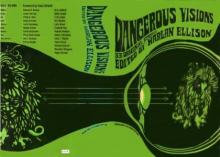 Flies
Flies The Silent Invaders
The Silent Invaders Ship-Sister, Star-Sister
Ship-Sister, Star-Sister